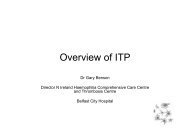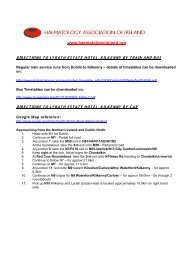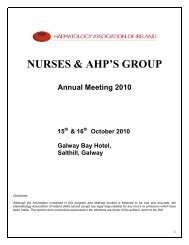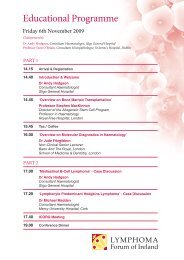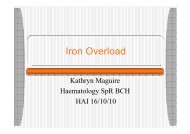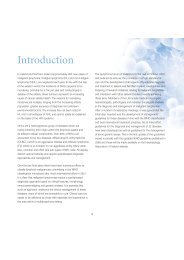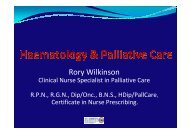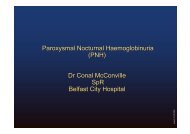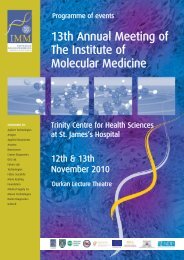Guidelines on Diagnosis and Treatment of Malignant Lymphomas
Guidelines on Diagnosis and Treatment of Malignant Lymphomas
Guidelines on Diagnosis and Treatment of Malignant Lymphomas
You also want an ePaper? Increase the reach of your titles
YUMPU automatically turns print PDFs into web optimized ePapers that Google loves.
■<br />
■<br />
Lymph node biopsy if there is palpable adenopathy.<br />
CT scans <strong>of</strong> the chest, abdomen <strong>and</strong> pelvis are indicated in<br />
patients with n<strong>on</strong>-mycosis fungoides CTCL variants, stage<br />
IIA/B/III/IV mycosis fungoides <strong>and</strong> Sezary syndrome.<br />
Scanning is not required in patients with stage IA/IB disease<br />
or lymphomatoid papulosis.<br />
Prognostic Factors / Index<br />
Prognosis in mycosis fungoides is related to age at presentati<strong>on</strong><br />
(worse if >60 years), clinical stage <strong>and</strong> elevated LDH. Patients<br />
with limited stage disease may have a normal life expectancy, but<br />
those with advanced disease have a poor prognosis, especially if<br />
there is extra-cutaneous disseminati<strong>on</strong>. Folliculotropic MF is less<br />
accessible to skin-targeted therapies because <strong>of</strong> deep dermal<br />
infiltrati<strong>on</strong> <strong>and</strong> disease-specific 5 year survival is approximately<br />
70-80% which is worse than classical MF. The median survival in<br />
Sézary syndrome is 32 m<strong>on</strong>ths from diagnosis with an overall<br />
survival <strong>of</strong> 10-20% at 5 years.<br />
Potential Pitfalls<br />
a. <strong>Diagnosis</strong> <strong>of</strong> cutaneous T cell lymphoma may be difficult<br />
<strong>and</strong> differential diagnosis includes a number <strong>of</strong> other entities<br />
including benign c<strong>on</strong>diti<strong>on</strong>s such as small <strong>and</strong> large plaque<br />
parapsoriasis, eczematous disorders <strong>and</strong> erythroderma<br />
sec<strong>on</strong>dary to drug reacti<strong>on</strong>s, psoriasis or eczema .<br />
b. Traditi<strong>on</strong>al anti-lymphoma regimens <strong>of</strong> combinati<strong>on</strong><br />
chemotherapy are not effective.<br />
<strong>Treatment</strong><br />
■ Patients should be jointly managed by an<br />
<strong>on</strong>cologist/haematologist <strong>and</strong> a dermatologist.<br />
■<br />
■<br />
■<br />
Skin-directed therapy (phototherapy, topical therapy or<br />
superficial radiotherapy) is appropriate for patients with early<br />
stage mycosis fungoides (stages IA-IIA) with the choice <strong>of</strong><br />
therapy dependent <strong>on</strong> the extent <strong>of</strong> cutaneous disease <strong>and</strong><br />
plaque thickness. Agents used include topical high-intensity<br />
steroids <strong>and</strong> bexarotene gel.<br />
Combined PUVA <strong>and</strong> α-interfer<strong>on</strong> therapy can be effective<br />
for patients with resistant early-stage disease (stage IB-IIA).<br />
Systemic therapy is required for patients with stage IIB<br />
or higher mycosis fungoides with interfer<strong>on</strong> or <strong>on</strong>e <strong>of</strong> the<br />
newer agents described below.<br />
Bexarotene is an oral retinoid with an overall resp<strong>on</strong>se rate<br />
<strong>of</strong> about 45% as m<strong>on</strong>otherapy which is increased when<br />
combined with interfer<strong>on</strong> <strong>and</strong>/or PUVA. Bexarotene causes<br />
central hypothyroidism <strong>and</strong> hypertryglyceridaemia which<br />
must be m<strong>on</strong>itored <strong>and</strong> treated appropriately<br />
■ Gemcitabine m<strong>on</strong>otherapy is also active in CTCL, using 1000<br />
mg/m2 <strong>on</strong> day 1,8 +/-15 resulting in an ORR <strong>of</strong> 68% in<br />
heavily pre-treated patients.<br />
■ Campath IH given iv or sc three times a week for up to 12<br />
weeks in patients with heavily pre-treated, advanced disease<br />
resulted in an ORR <strong>of</strong> 38%-55%, but associated with a high<br />
incidence <strong>of</strong> infecti<strong>on</strong>s<br />
52



